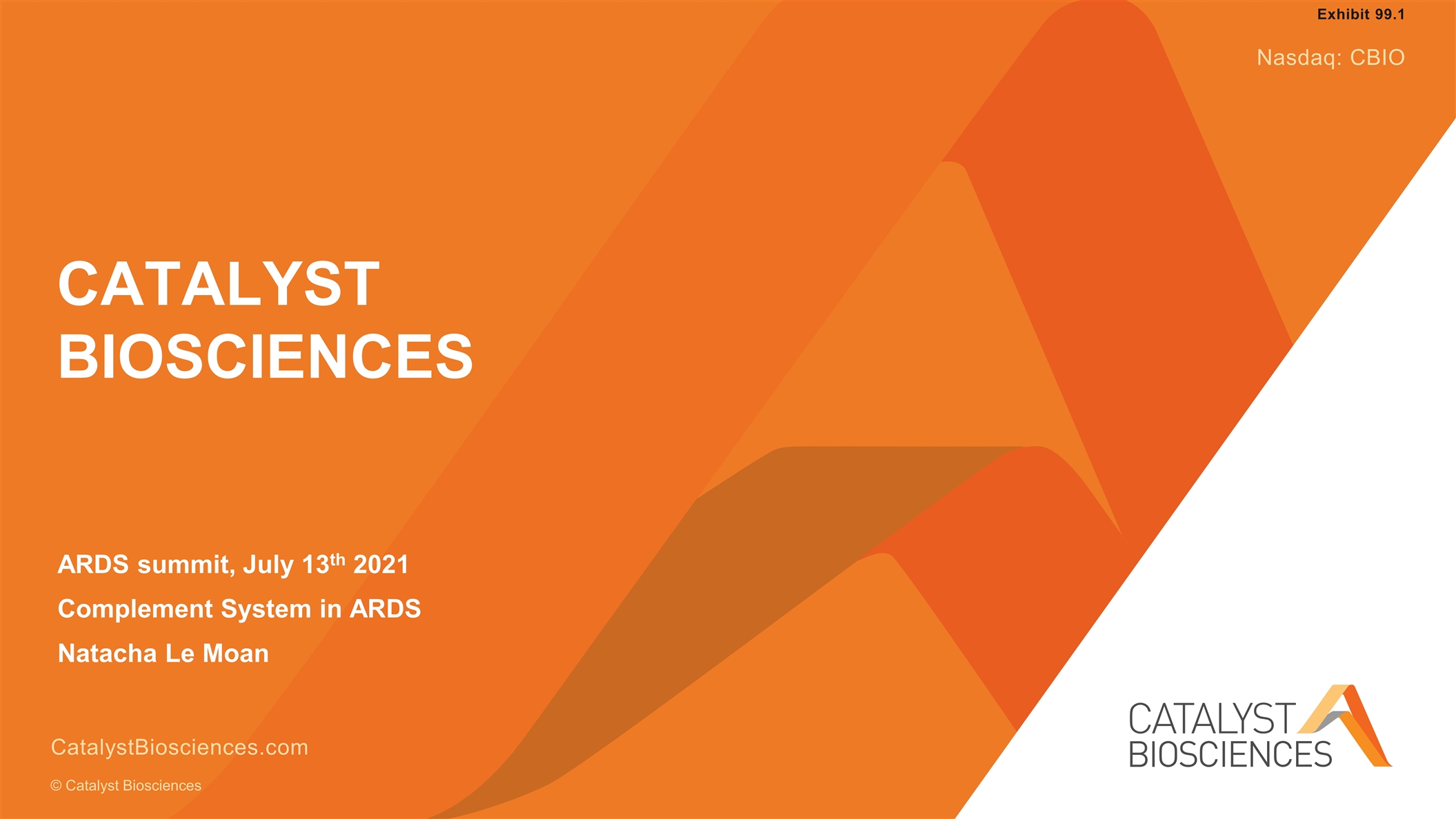
Catalyst Biosciences © Catalyst Biosciences ARDS summit, July 13th 2021 Complement System in ARDS Natacha Le Moan Exhibit 99.1
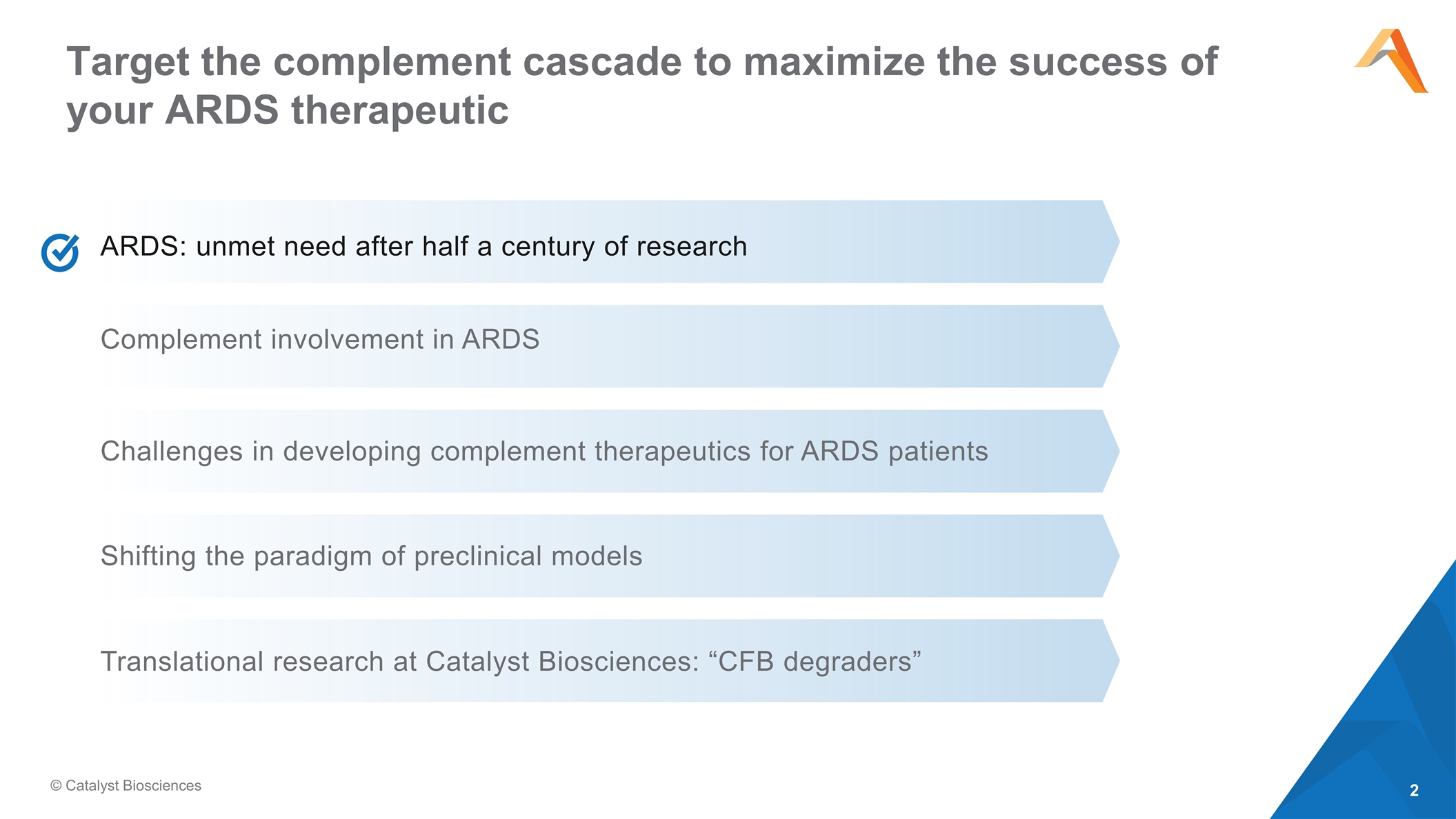
Target the complement cascade to maximize the success of your ARDS therapeutic © Catalyst Biosciences ARDS: unmet need after half a century of research Complement involvement in ARDS Challenges in developing complement therapeutics for ARDS patients Translational research at Catalyst Biosciences: “CFB degraders” Shifting the paradigm of preclinical models
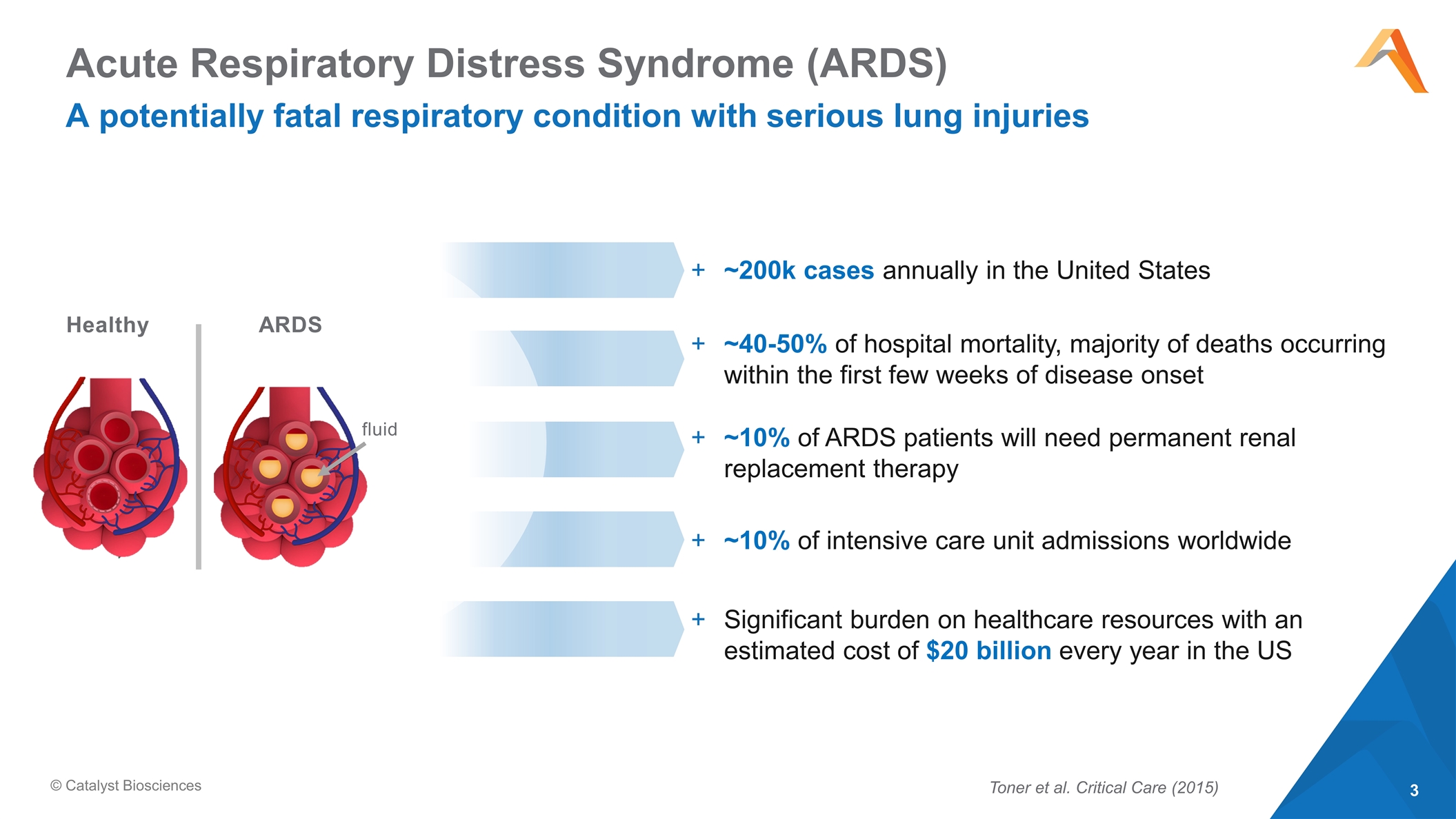
Acute Respiratory Distress Syndrome (ARDS) A potentially fatal respiratory condition with serious lung injuries © Catalyst Biosciences ~40-50% of hospital mortality, majority of deaths occurring within the first few weeks of disease onset Significant burden on healthcare resources with an estimated cost of $20 billion every year in the US ~200k cases annually in the United States Healthy ARDS fluid ~10% of intensive care unit admissions worldwide ~10% of ARDS patients will need permanent renal replacement therapy Toner et al. Critical Care (2015)
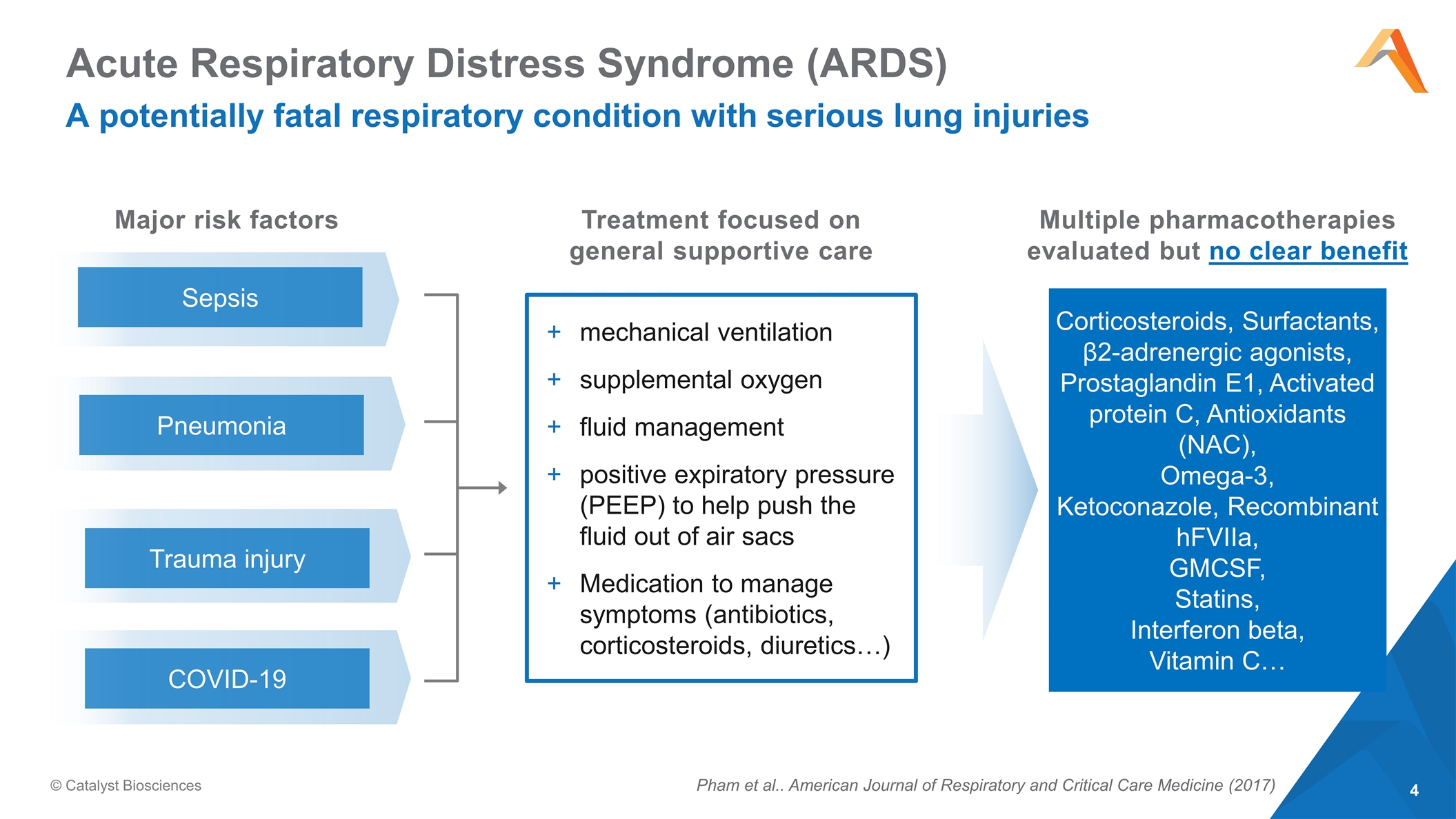
Acute Respiratory Distress Syndrome (ARDS) A potentially fatal respiratory condition with serious lung injuries © Catalyst Biosciences Pham et al.. American Journal of Respiratory and Critical Care Medicine (2017) Sepsis Pneumonia Trauma injury COVID-19 Major risk factors mechanical ventilation supplemental oxygen fluid management positive expiratory pressure (PEEP) to help push the fluid out of air sacs Medication to manage symptoms (antibiotics, corticosteroids, diuretics…) Treatment focused on general supportive care Multiple pharmacotherapies evaluated but no clear benefit Corticosteroids, Surfactants, β2-adrenergic agonists, Prostaglandin E1, Activated protein C, Antioxidants (NAC), Omega-3, Ketoconazole, Recombinant hFVIIa, GMCSF, Statins, Interferon beta, Vitamin C…
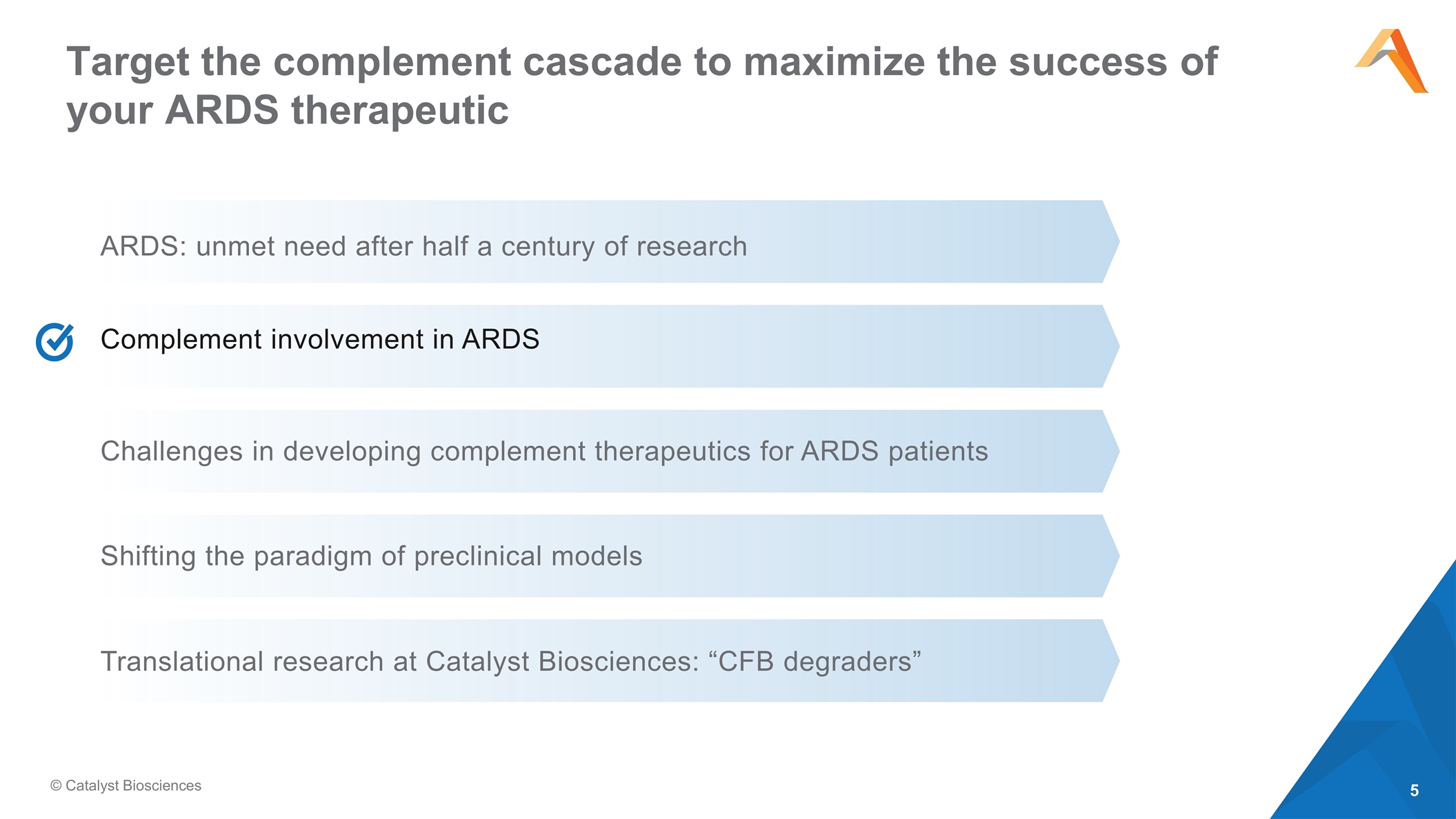
Target the complement cascade to maximize the success of your ARDS therapeutic © Catalyst Biosciences ARDS: unmet need after half a century of research Complement involvement in ARDS Challenges in developing complement therapeutics for ARDS patients Translational research at Catalyst Biosciences: “CFB degraders” Shifting the paradigm of preclinical models
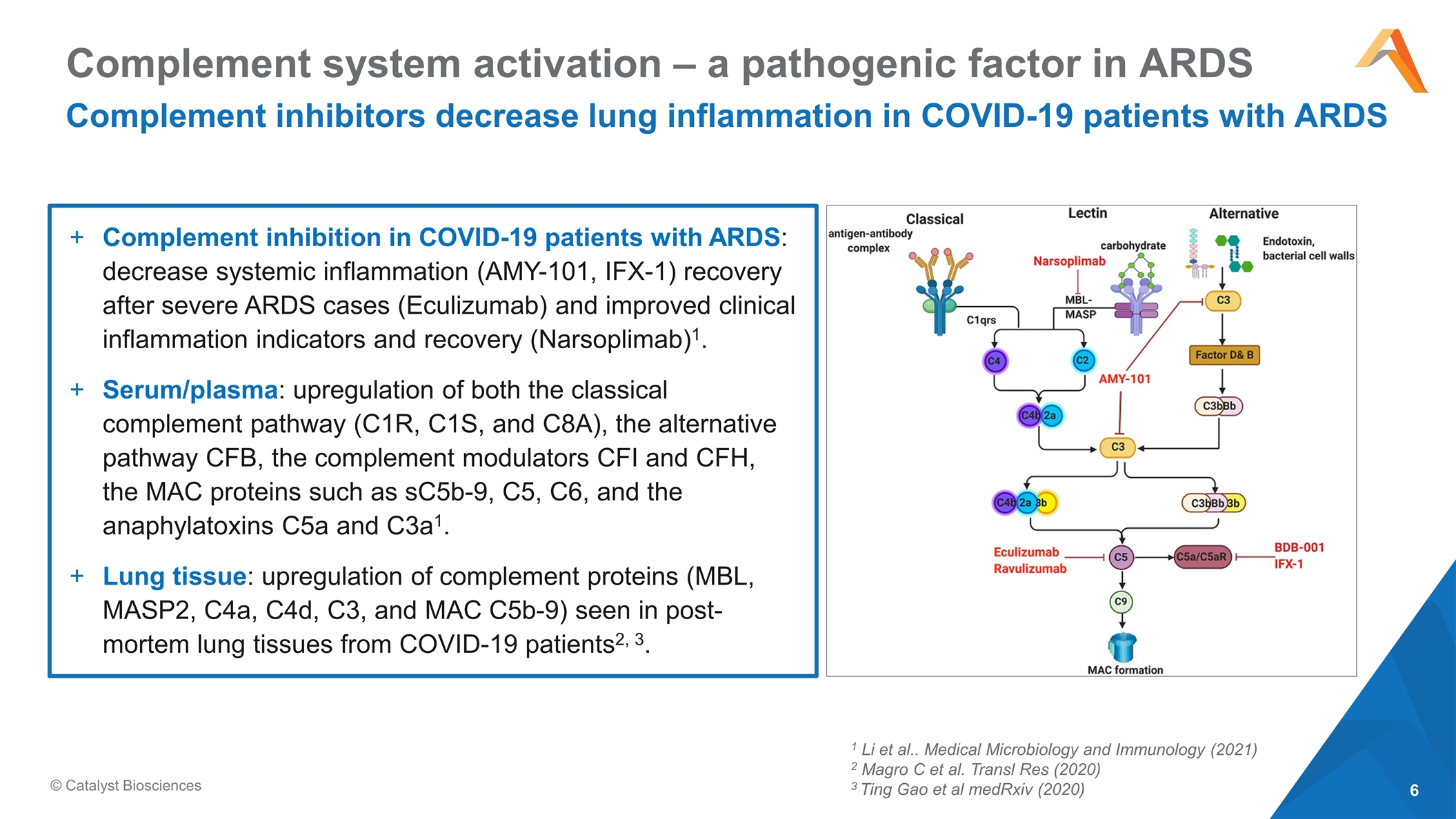
Complement system activation – a pathogenic factor in ARDS Complement inhibitors decrease lung inflammation in COVID-19 patients with ARDS © Catalyst Biosciences Complement inhibition in COVID-19 patients with ARDS: decrease systemic inflammation (AMY-101, IFX-1) recovery after severe ARDS cases (Eculizumab) and improved clinical inflammation indicators and recovery (Narsoplimab)1. Serum/plasma: upregulation of both the classical complement pathway (C1R, C1S, and C8A), the alternative pathway CFB, the complement modulators CFI and CFH, the MAC proteins such as sC5b-9, C5, C6, and the anaphylatoxins C5a and C3a1. Lung tissue: upregulation of complement proteins (MBL, MASP2, C4a, C4d, C3, and MAC C5b-9) seen in post-mortem lung tissues from COVID-19 patients2, 3. 1 Li et al.. Medical Microbiology and Immunology (2021) 2 Magro C et al. Transl Res (2020) 3 Ting Gao et al medRxiv (2020)
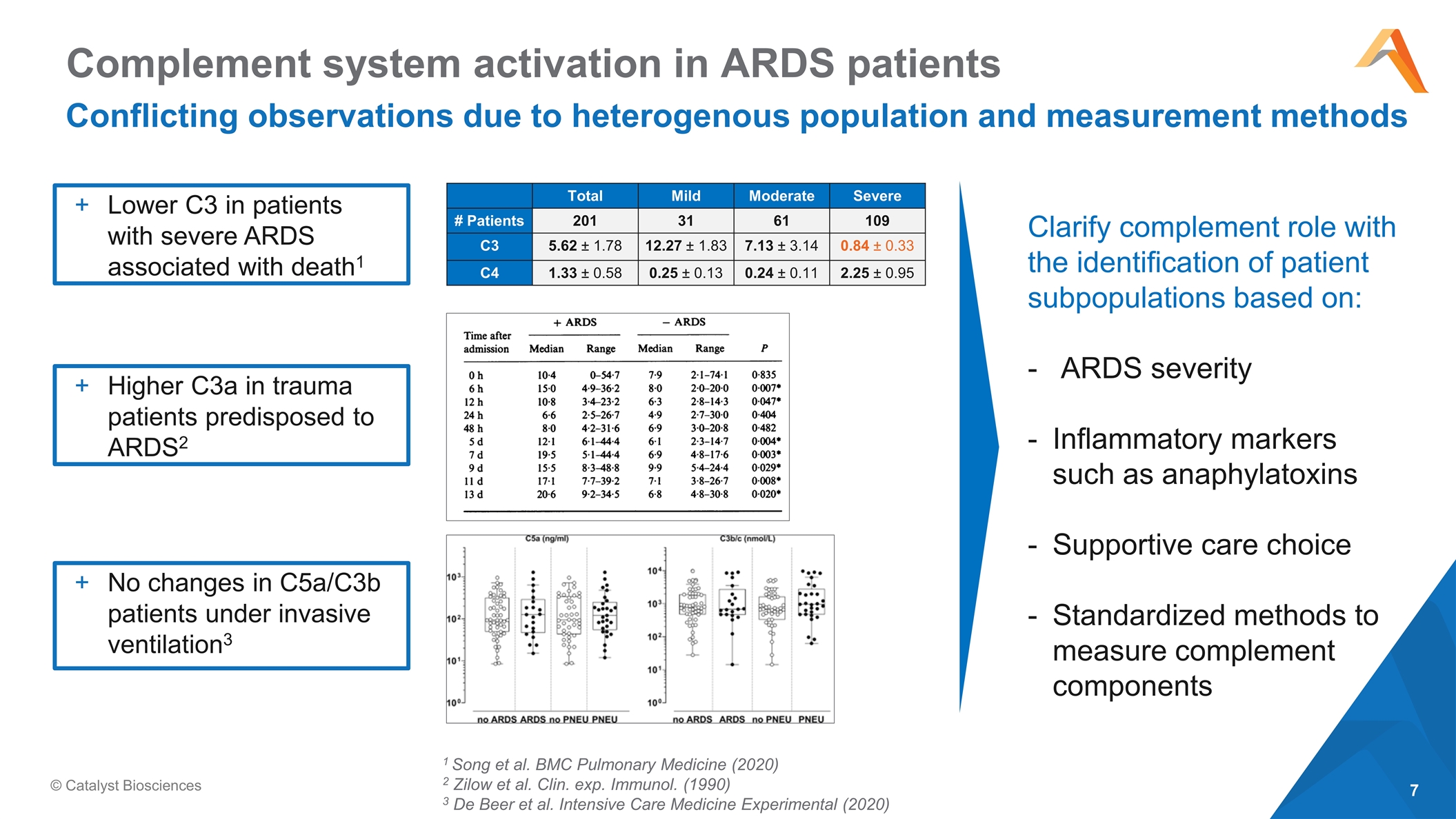
Complement system activation in ARDS patients Conflicting observations due to heterogenous population and measurement methods © Catalyst Biosciences Lower C3 in patients with severe ARDS associated with death1 No changes in C5a/C3b patients under invasive ventilation3 Clarify complement role with the identification of patient subpopulations based on: ARDS severity Inflammatory markers such as anaphylatoxins Supportive care choice Standardized methods to measure complement components Higher C3a in trauma patients predisposed to ARDS2 1 Song et al. BMC Pulmonary Medicine (2020) 2 Zilow et al. Clin. exp. Immunol. (1990) 3 De Beer et al. Intensive Care Medicine Experimental (2020) Total Mild Moderate Severe # Patients 201 31 61 109 C3 5.62 ± 1.78 12.27 ± 1.83 7.13 ± 3.14 0.84 ± 0.33 C4 1.33 ± 0.58 0.25 ± 0.13 0.24 ± 0.11 2.25 ± 0.95
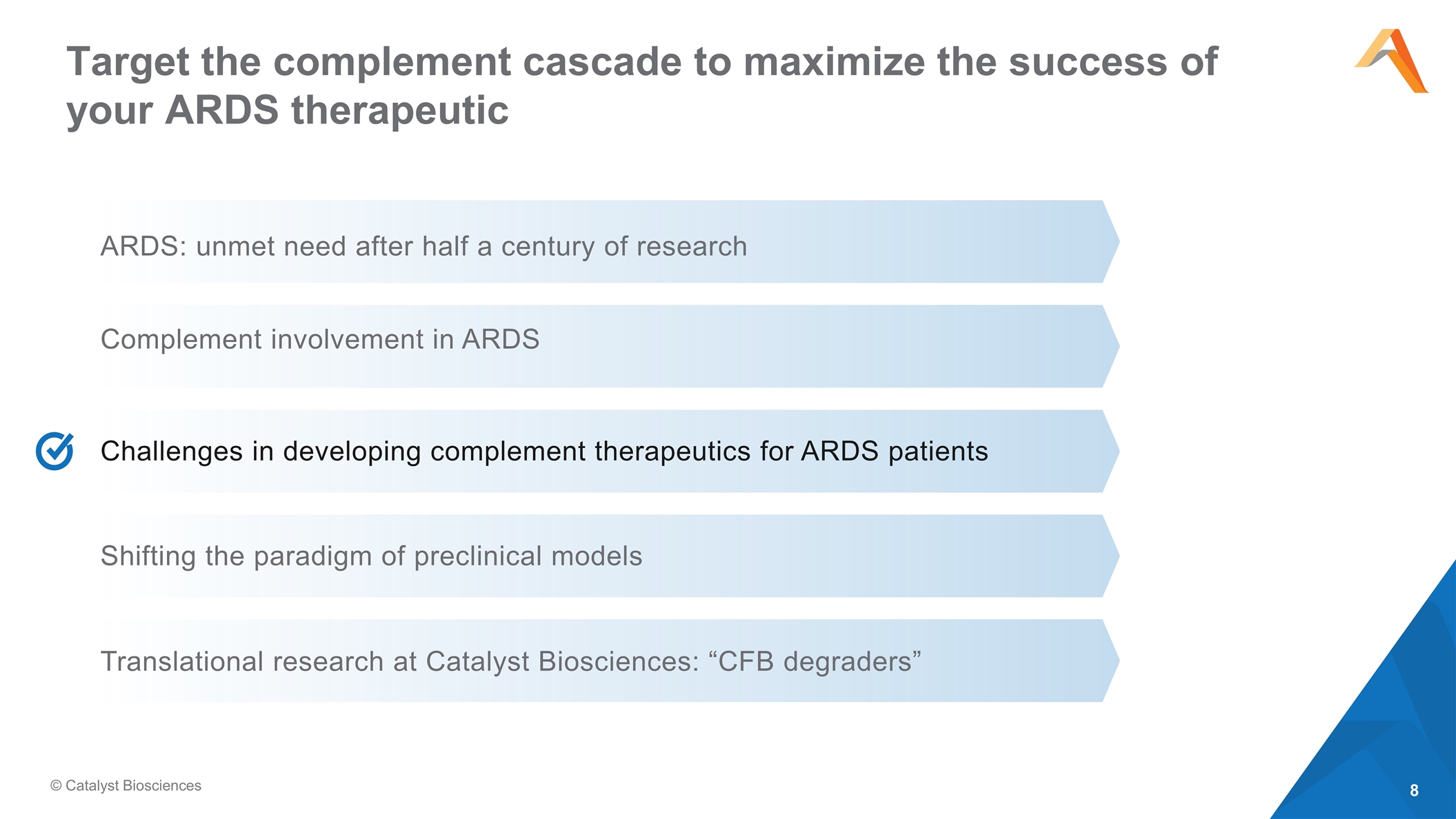
Target the complement cascade to maximize the success of your ARDS therapeutic © Catalyst Biosciences ARDS: unmet need after half a century of research Complement involvement in ARDS Challenges in developing complement therapeutics for ARDS patients Translational research at Catalyst Biosciences: “CFB degraders” Shifting the paradigm of preclinical models
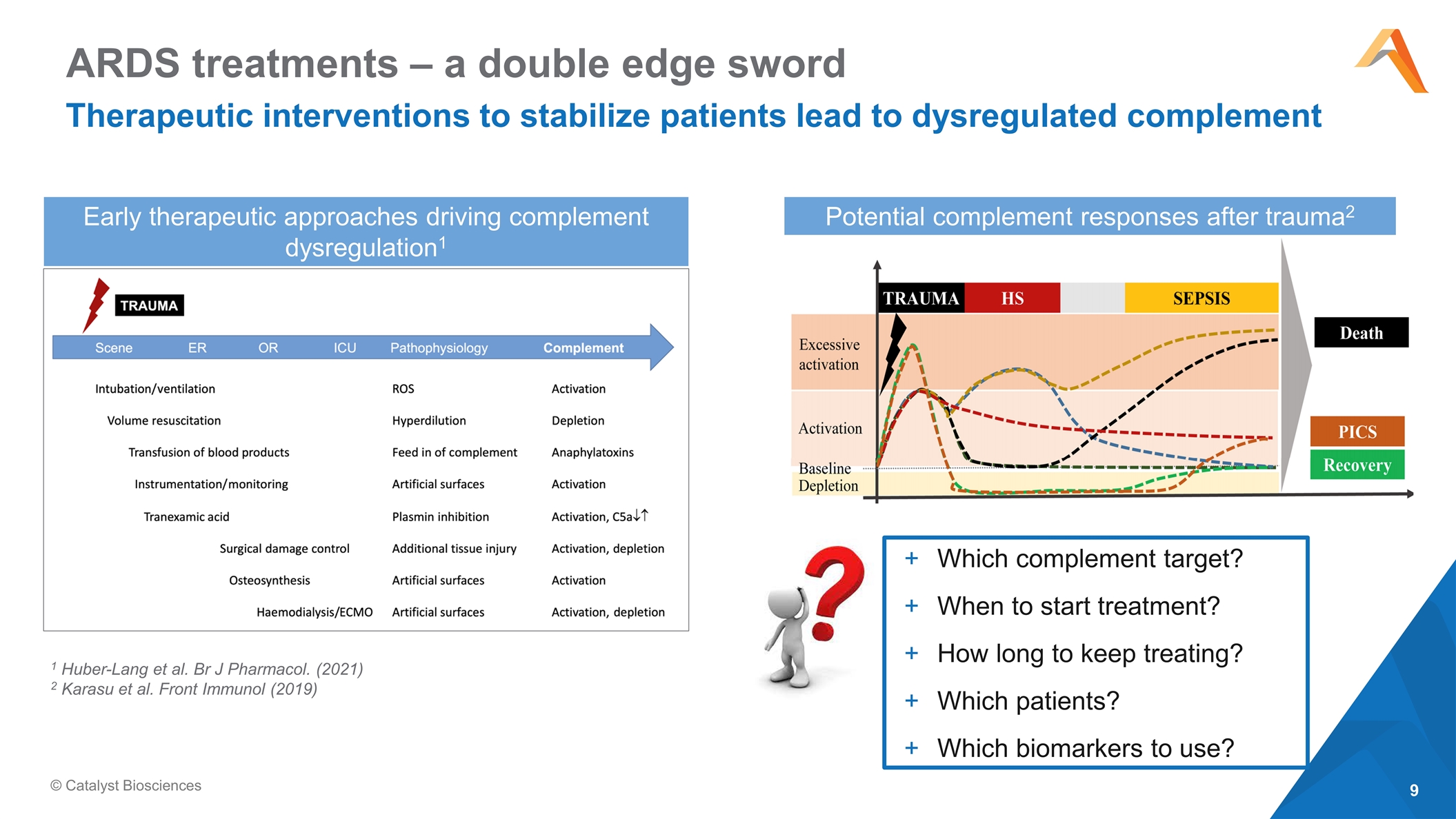
ARDS treatments – a double edge sword Therapeutic interventions to stabilize patients lead to dysregulated complement © Catalyst Biosciences 1 Huber-Lang et al. Br J Pharmacol. (2021) 2 Karasu et al. Front Immunol (2019) Early therapeutic approaches driving complement dysregulation1 Which complement target? When to start treatment? How long to keep treating? Which patients? Which biomarkers to use? Potential complement responses after trauma2
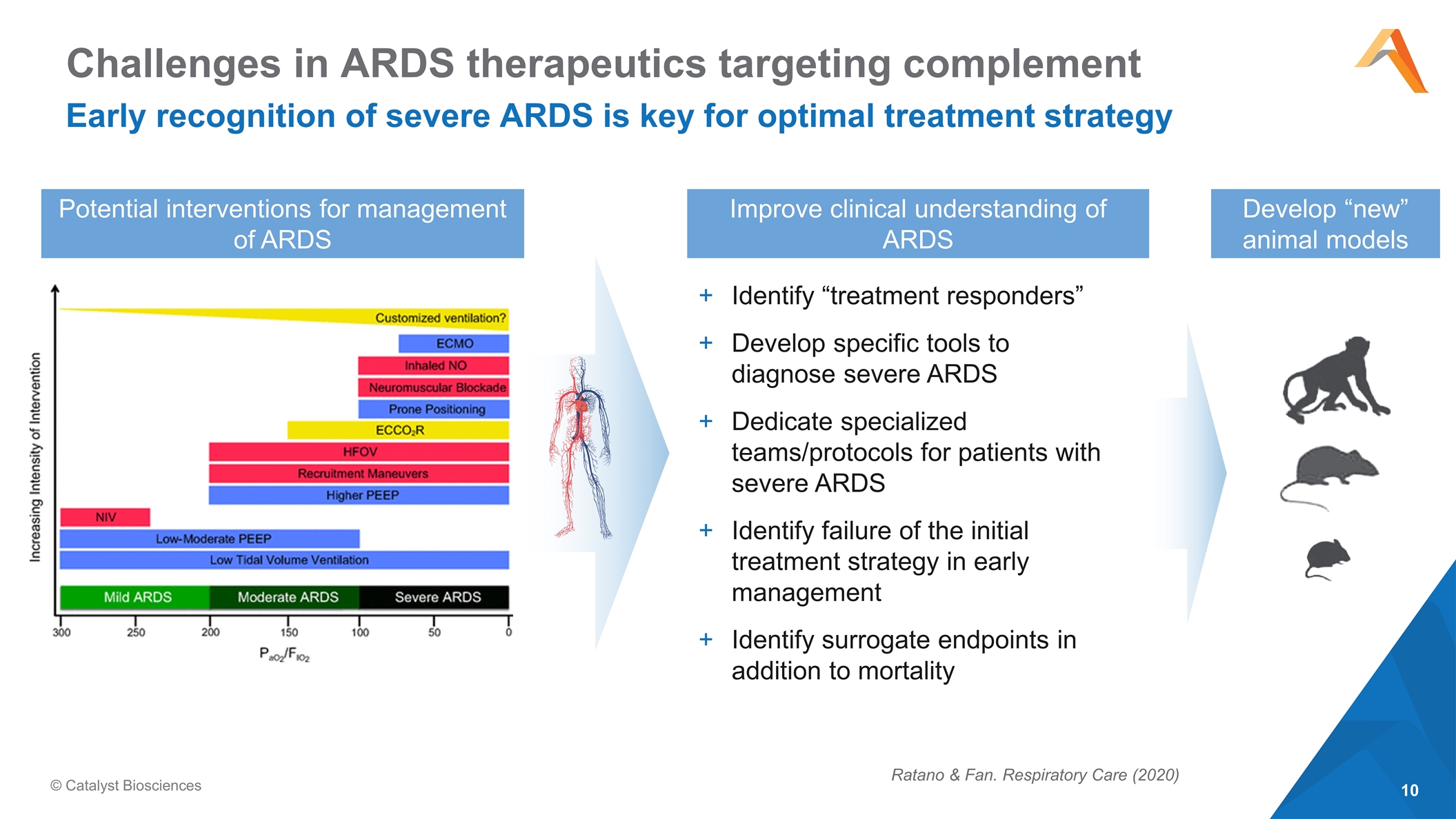
Challenges in ARDS therapeutics targeting complement Early recognition of severe ARDS is key for optimal treatment strategy © Catalyst Biosciences Ratano & Fan. Respiratory Care (2020) Potential interventions for management of ARDS Improve clinical understanding of ARDS Identify “treatment responders” Develop specific tools to diagnose severe ARDS Dedicate specialized teams/protocols for patients with severe ARDS Identify failure of the initial treatment strategy in early management Identify surrogate endpoints in addition to mortality Develop “new” animal models
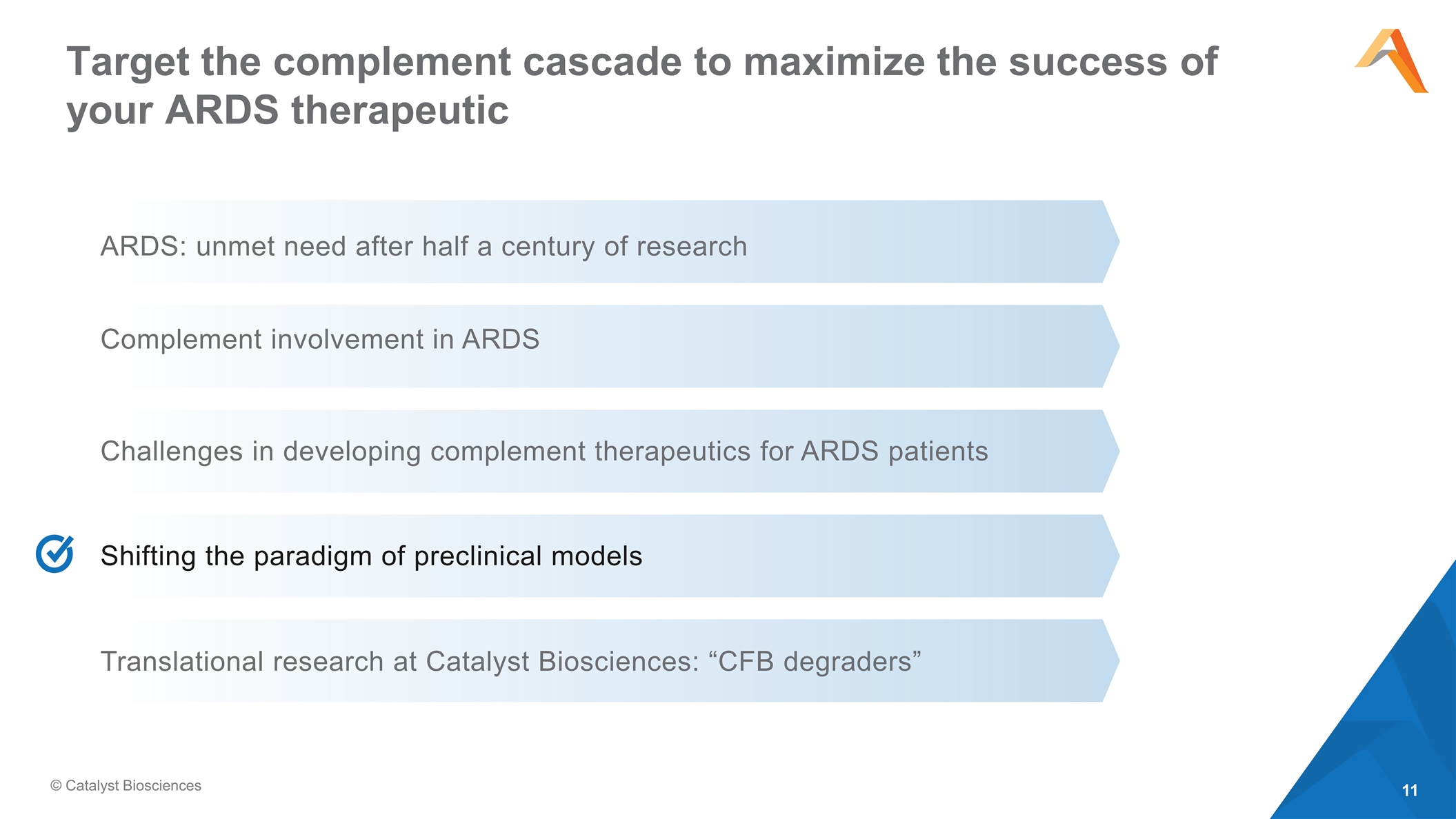
Target the complement cascade to maximize the success of your ARDS therapeutic © Catalyst Biosciences ARDS: unmet need after half a century of research Complement involvement in ARDS Challenges in developing complement therapeutics for ARDS patients Translational research at Catalyst Biosciences: “CFB degraders” Shifting the paradigm of preclinical models
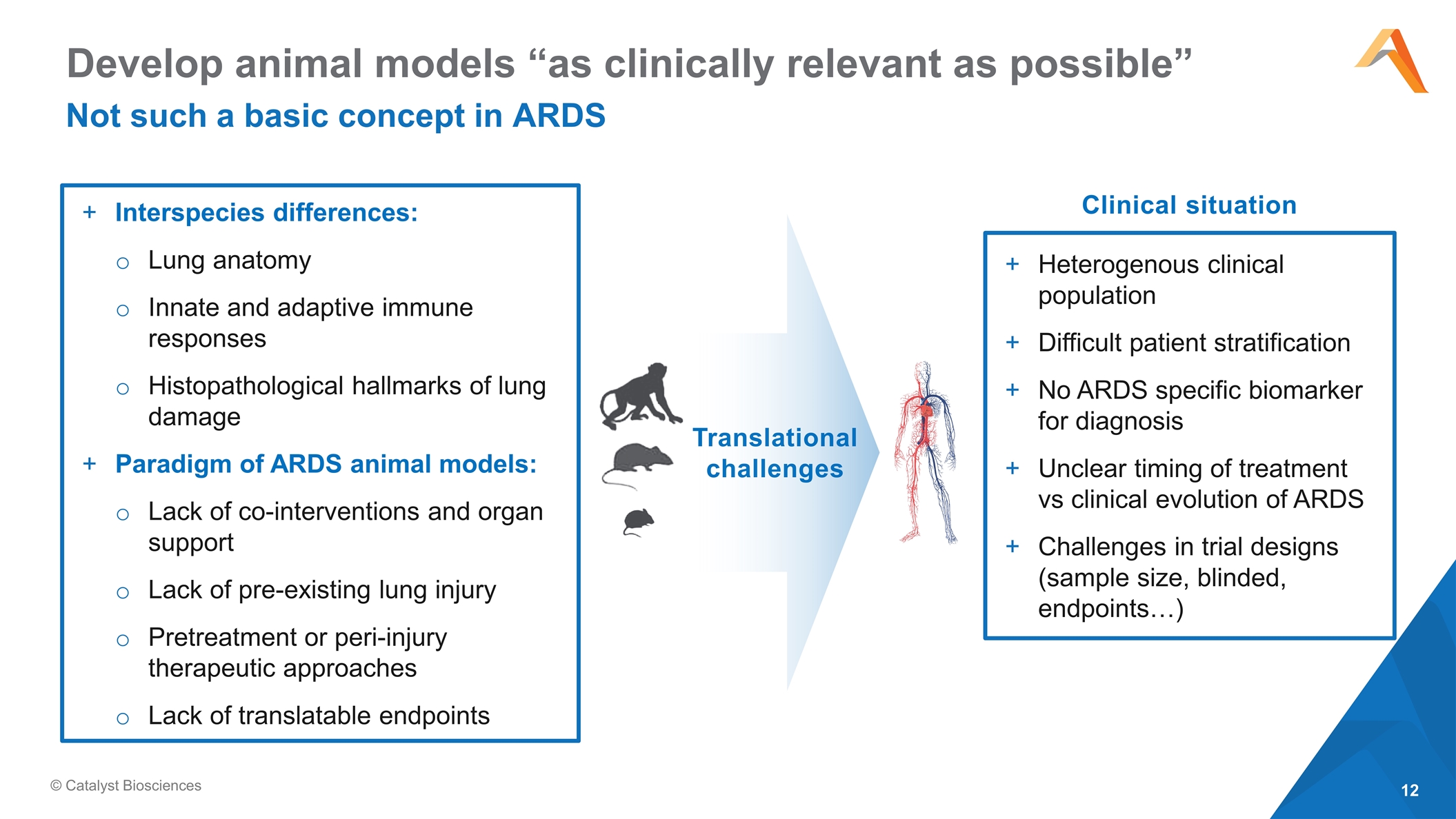
Develop animal models “as clinically relevant as possible” Not such a basic concept in ARDS © Catalyst Biosciences Interspecies differences: Lung anatomy Innate and adaptive immune responses Histopathological hallmarks of lung damage Paradigm of ARDS animal models: Lack of co-interventions and organ support Lack of pre-existing lung injury Pretreatment or peri-injury therapeutic approaches Lack of translatable endpoints Heterogenous clinical population Difficult patient stratification No ARDS specific biomarker for diagnosis Unclear timing of treatment vs clinical evolution of ARDS Challenges in trial designs (sample size, blinded, endpoints…) Translational challenges Clinical situation
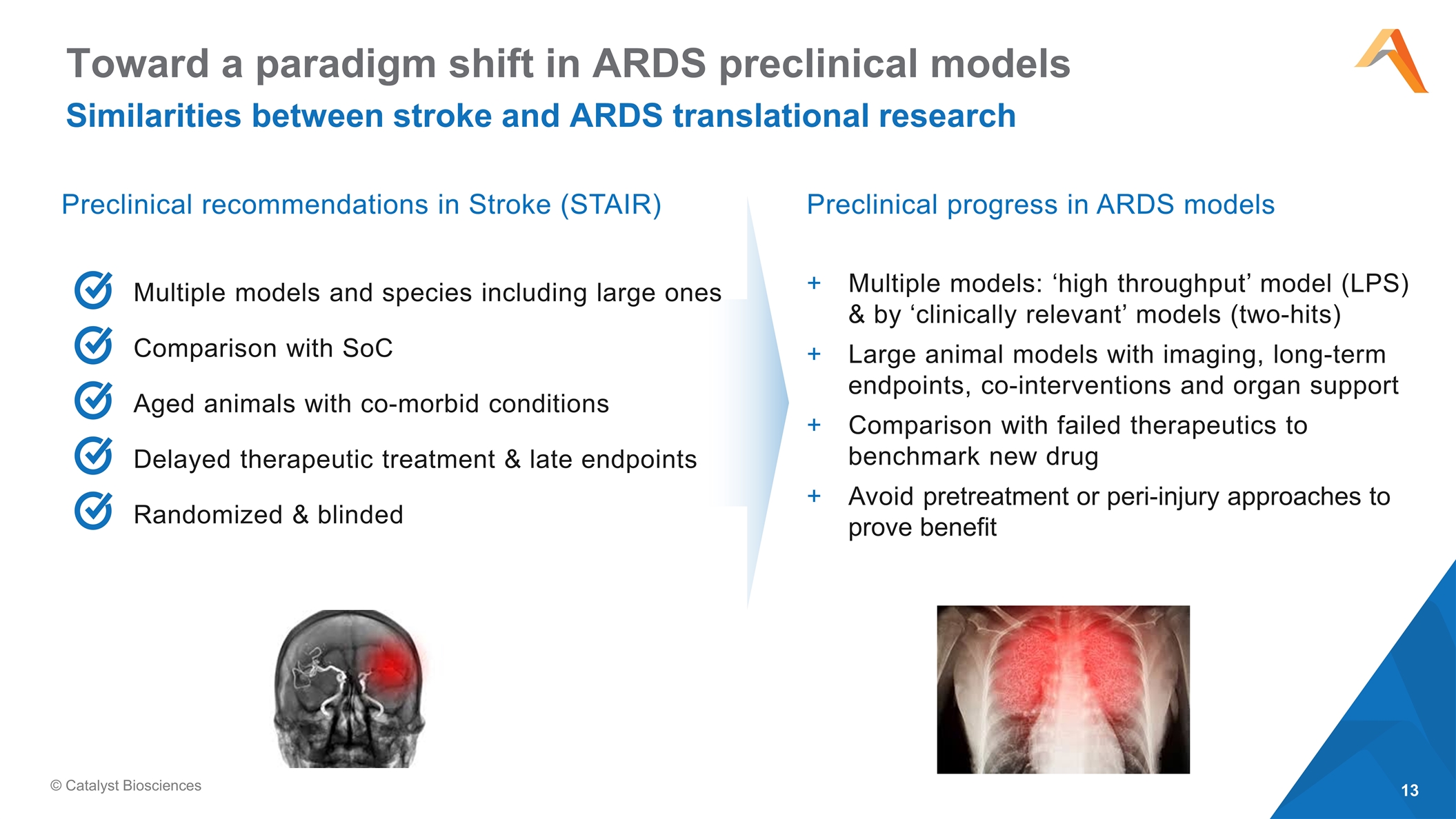
Toward a paradigm shift in ARDS preclinical models Similarities between stroke and ARDS translational research © Catalyst Biosciences Multiple models and species including large ones Comparison with SoC Aged animals with co-morbid conditions Delayed therapeutic treatment & late endpoints Randomized & blinded Preclinical recommendations in Stroke (STAIR) Preclinical progress in ARDS models Multiple models: ‘high throughput’ model (LPS) & by ‘clinically relevant’ models (two-hits) Large animal models with imaging, long-term endpoints, co-interventions and organ support Comparison with failed therapeutics to benchmark new drug Avoid pretreatment or peri-injury approaches to prove benefit
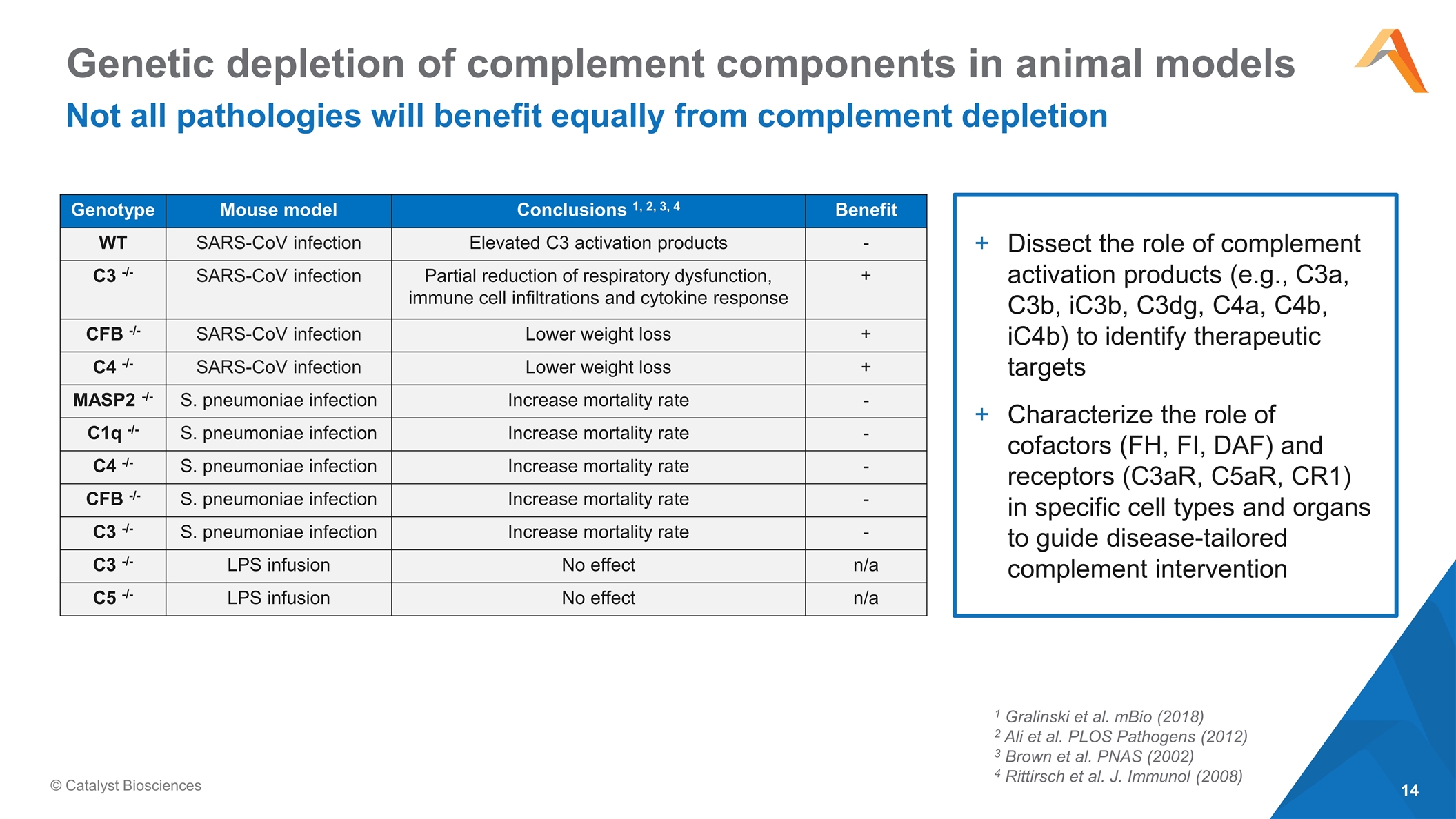
Genetic depletion of complement components in animal models Not all pathologies will benefit equally from complement depletion © Catalyst Biosciences 1 Gralinski et al. mBio (2018) 2 Ali et al. PLOS Pathogens (2012) 3 Brown et al. PNAS (2002) 4 Rittirsch et al. J. Immunol (2008) Genotype Mouse model Conclusions 1, 2, 3, 4 Benefit WT SARS-CoV infection Elevated C3 activation products - C3 -/- SARS-CoV infection Partial reduction of respiratory dysfunction, immune cell infiltrations and cytokine response + CFB -/- SARS-CoV infection Lower weight loss + C4 -/- SARS-CoV infection Lower weight loss + MASP2 -/- S. pneumoniae infection Increase mortality rate - C1q -/- S. pneumoniae infection Increase mortality rate - C4 -/- S. pneumoniae infection Increase mortality rate - CFB -/- S. pneumoniae infection Increase mortality rate - C3 -/- S. pneumoniae infection Increase mortality rate - C3 -/- LPS infusion No effect n/a C5 -/- LPS infusion No effect n/a Dissect the role of complement activation products (e.g., C3a, C3b, iC3b, C3dg, C4a, C4b, iC4b) to identify therapeutic targets Characterize the role of cofactors (FH, FI, DAF) and receptors (C3aR, C5aR, CR1) in specific cell types and organs to guide disease-tailored complement intervention
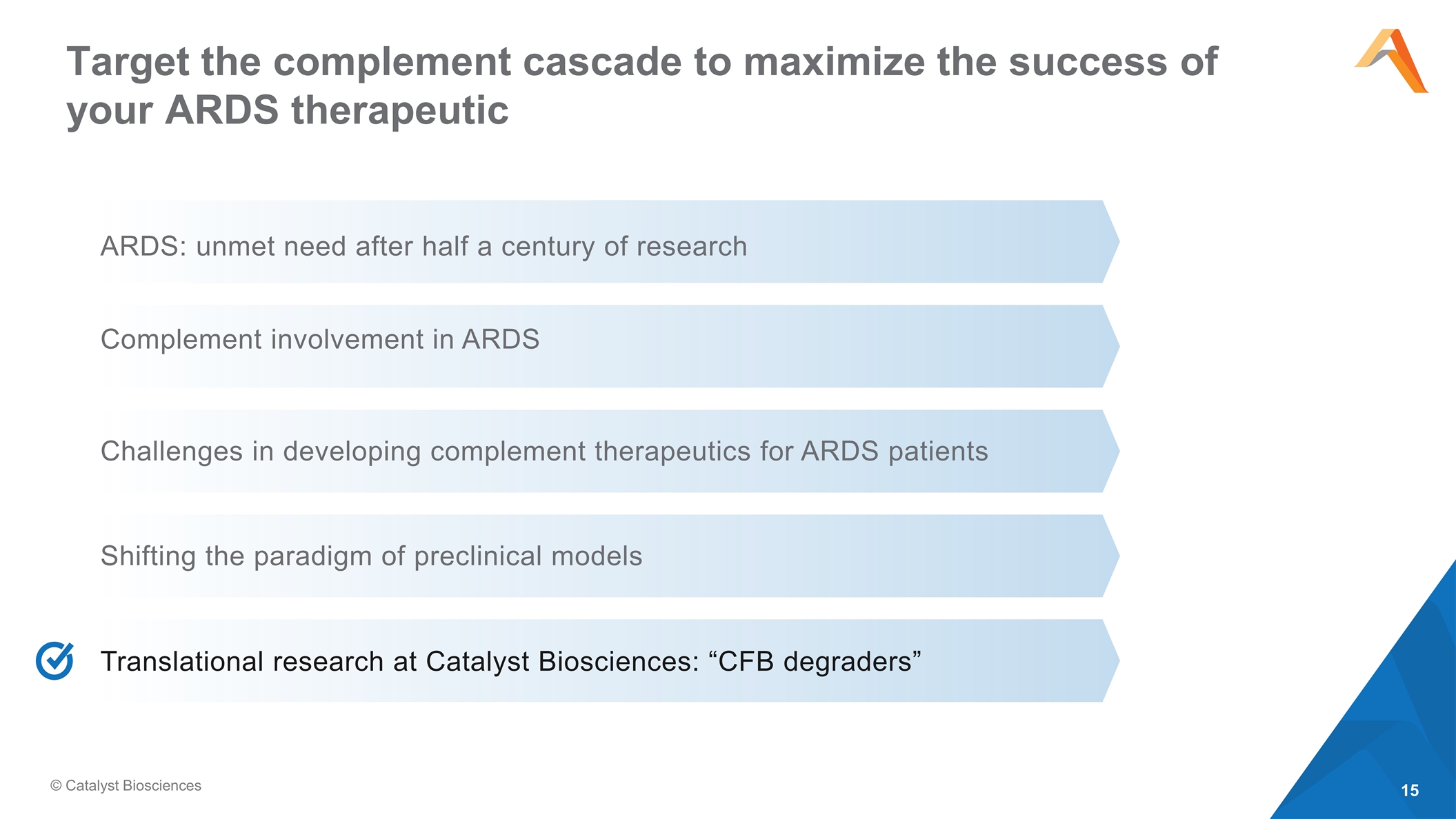
Target the complement cascade to maximize the success of your ARDS therapeutic © Catalyst Biosciences ARDS: unmet need after half a century of research Complement involvement in ARDS Challenges in developing complement therapeutics for ARDS patients Translational research at Catalyst Biosciences: “CFB degraders” Shifting the paradigm of preclinical models
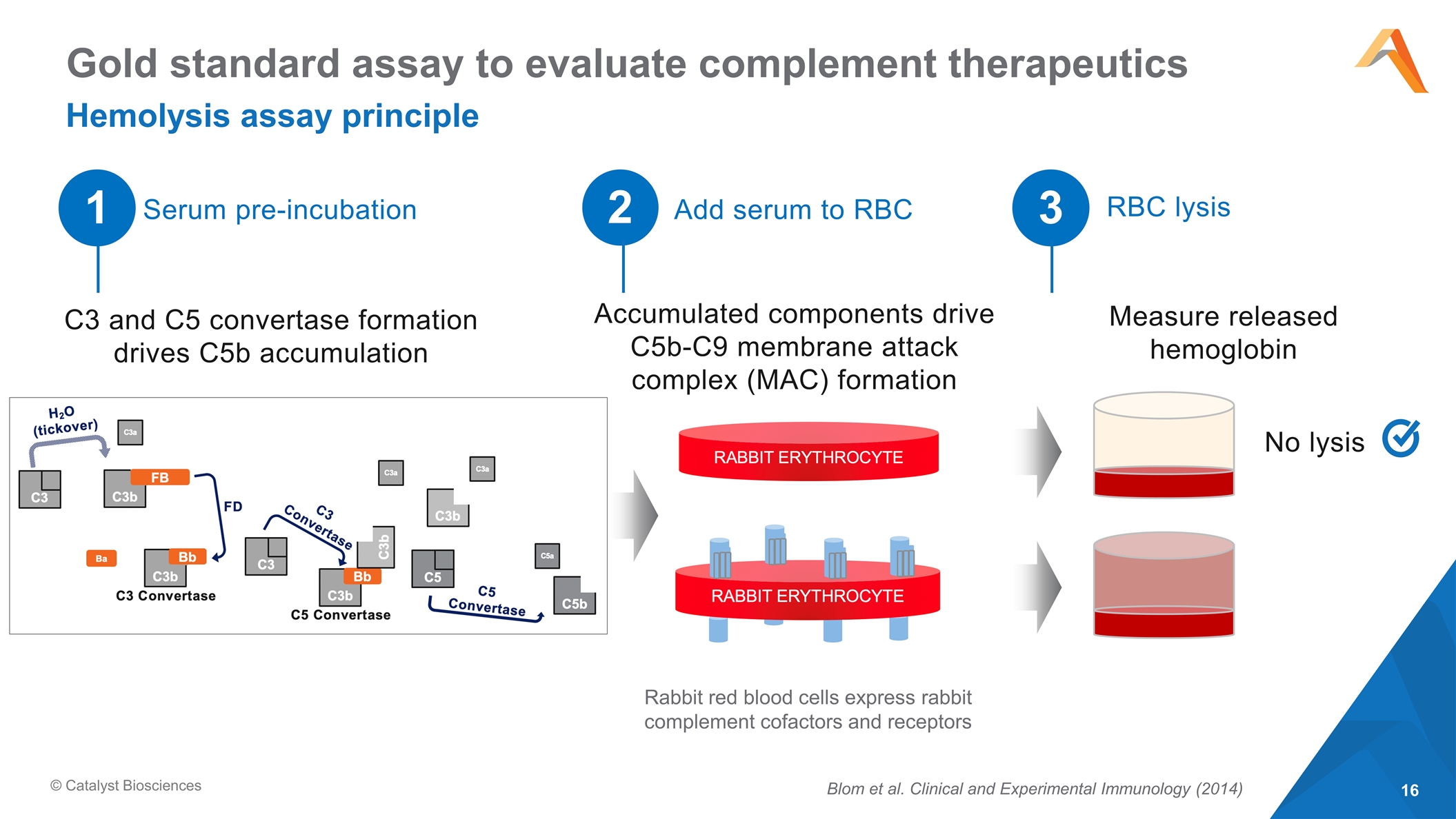
Gold standard assay to evaluate complement therapeutics Hemolysis assay principle © Catalyst Biosciences 2 3 1 C3 and C5 convertase formation drives C5b accumulation Serum pre-incubation Accumulated components drive C5b-C9 membrane attack complex (MAC) formation Add serum to RBC Measure released hemoglobin Lysis RBC lysis No lysis Blom et al. Clinical and Experimental Immunology (2014) Rabbit red blood cells express rabbit complement cofactors and receptors
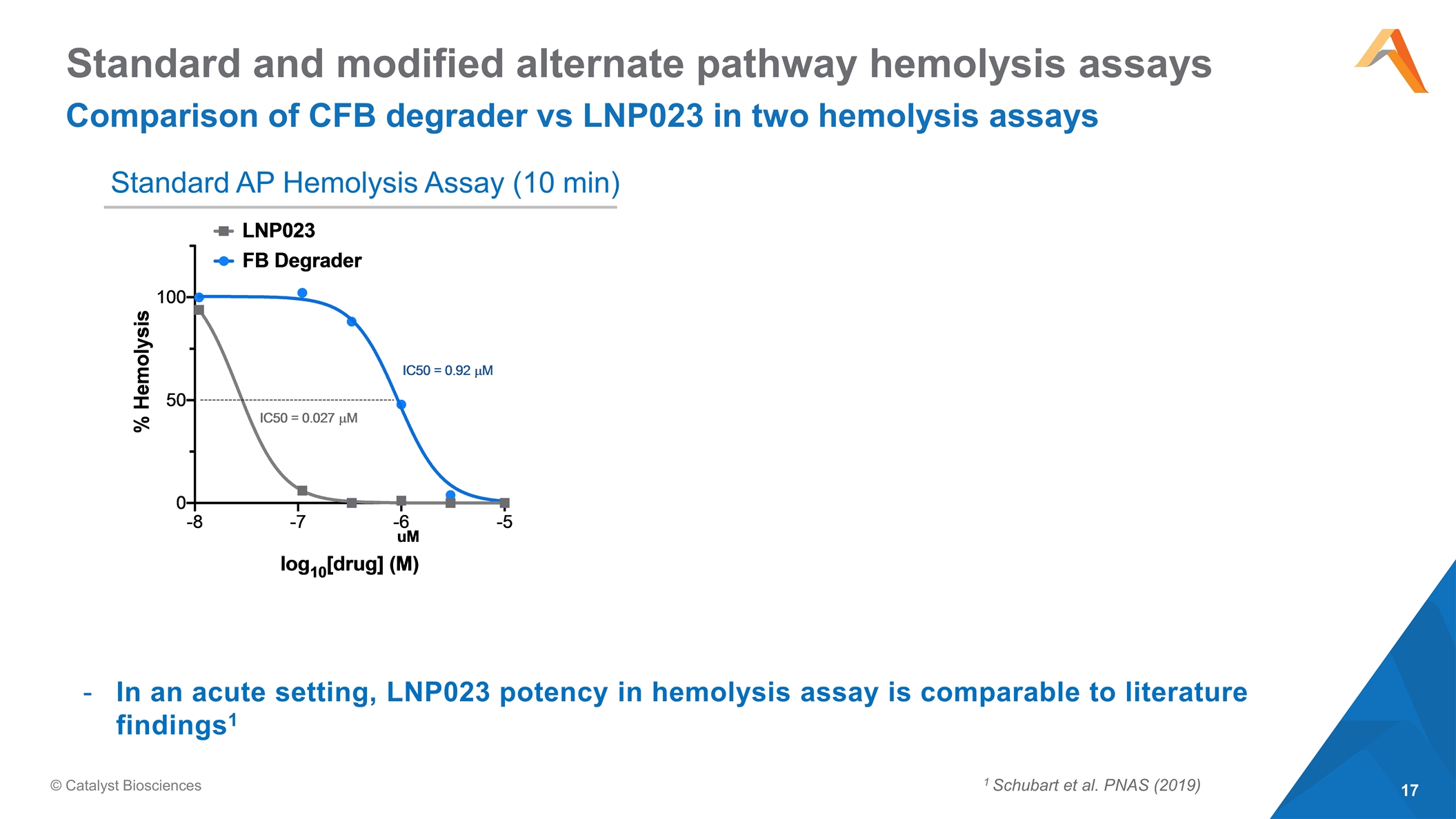
Comparison of CFB degrader vs LNP023 in two hemolysis assays © Catalyst Biosciences Standard and modified alternate pathway hemolysis assays Standard AP Hemolysis Assay (10 min) In an acute setting, LNP023 potency in hemolysis assay is comparable to literature findings1 1 Schubart et al. PNAS (2019)
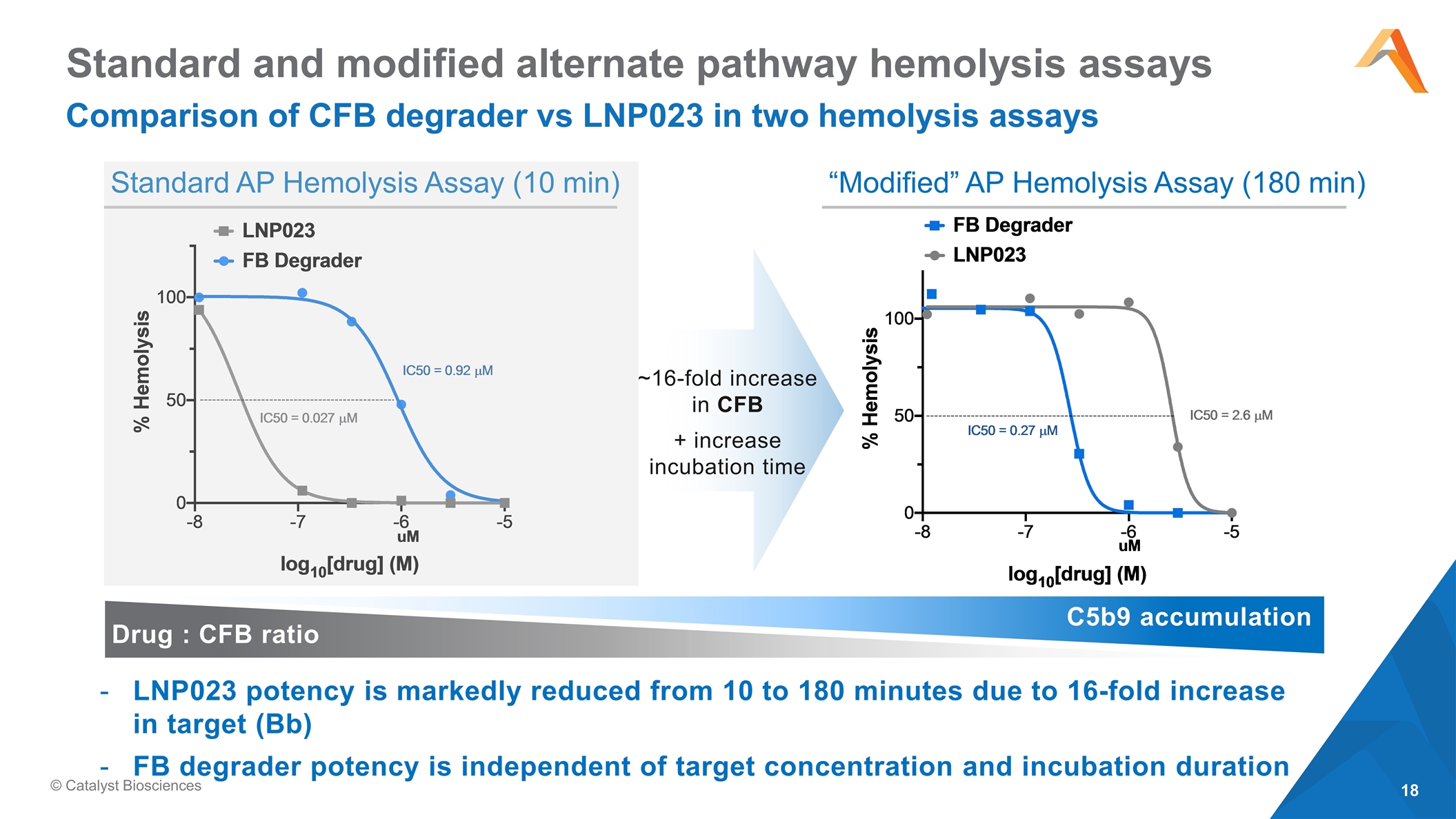
Comparison of CFB degrader vs LNP023 in two hemolysis assays © Catalyst Biosciences Standard and modified alternate pathway hemolysis assays LNP023 potency is markedly reduced from 10 to 180 minutes due to 16-fold increase in target (Bb) FB degrader potency is independent of target concentration and incubation duration Standard AP Hemolysis Assay (10 min) “Modified” AP Hemolysis Assay (180 min) Drug : CFB ratio C5b9 accumulation ~16-fold increase in CFB + increase incubation time
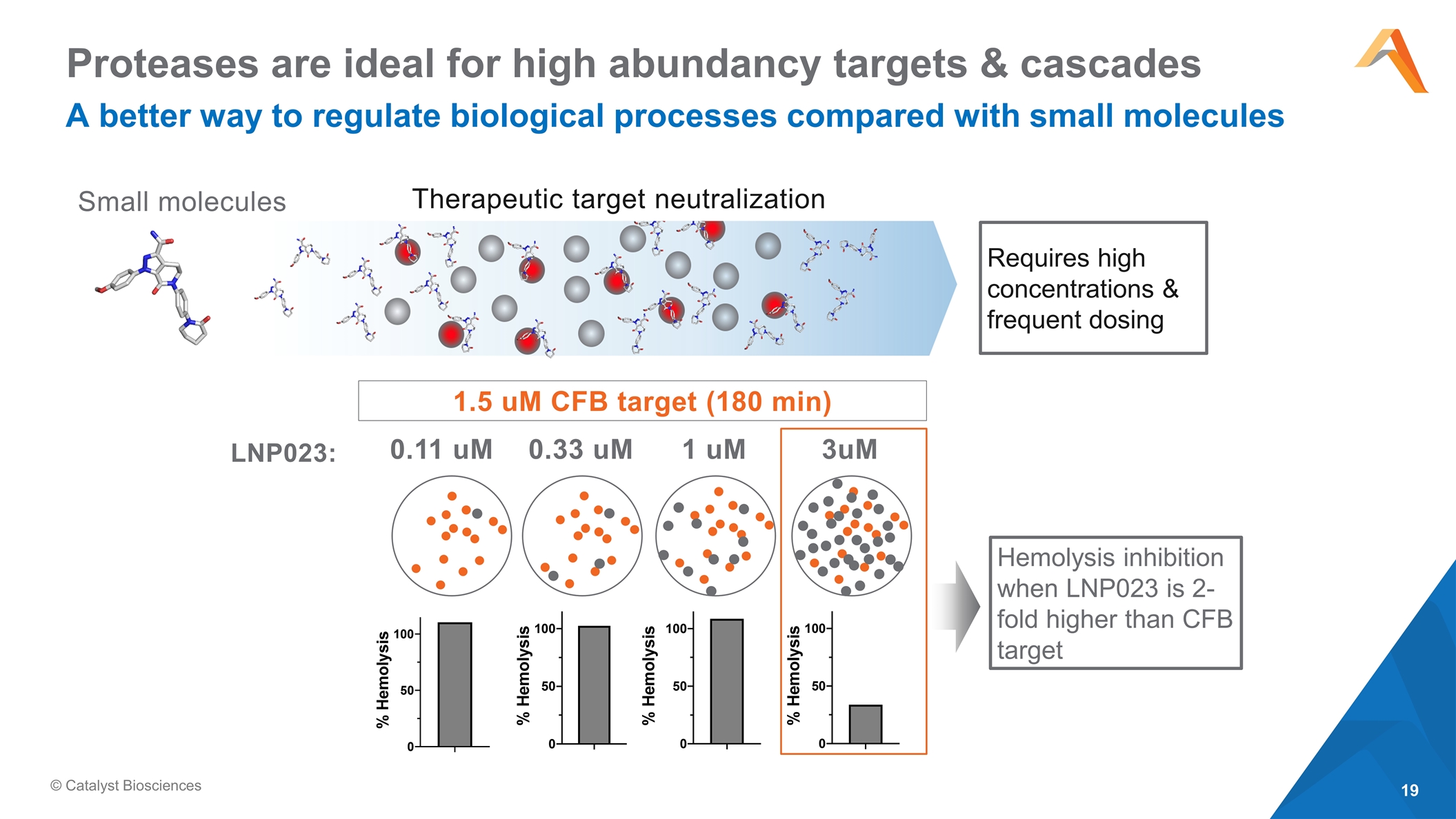
Proteases are ideal for high abundancy targets & cascades A better way to regulate biological processes compared with small molecules © Catalyst Biosciences Requires high concentrations & frequent dosing LNP023: Small molecules 3uM 1.5 uM CFB target (180 min) 1 uM 0.33 uM 0.11 uM Therapeutic target neutralization Hemolysis inhibition when LNP023 is 2-fold higher than CFB target
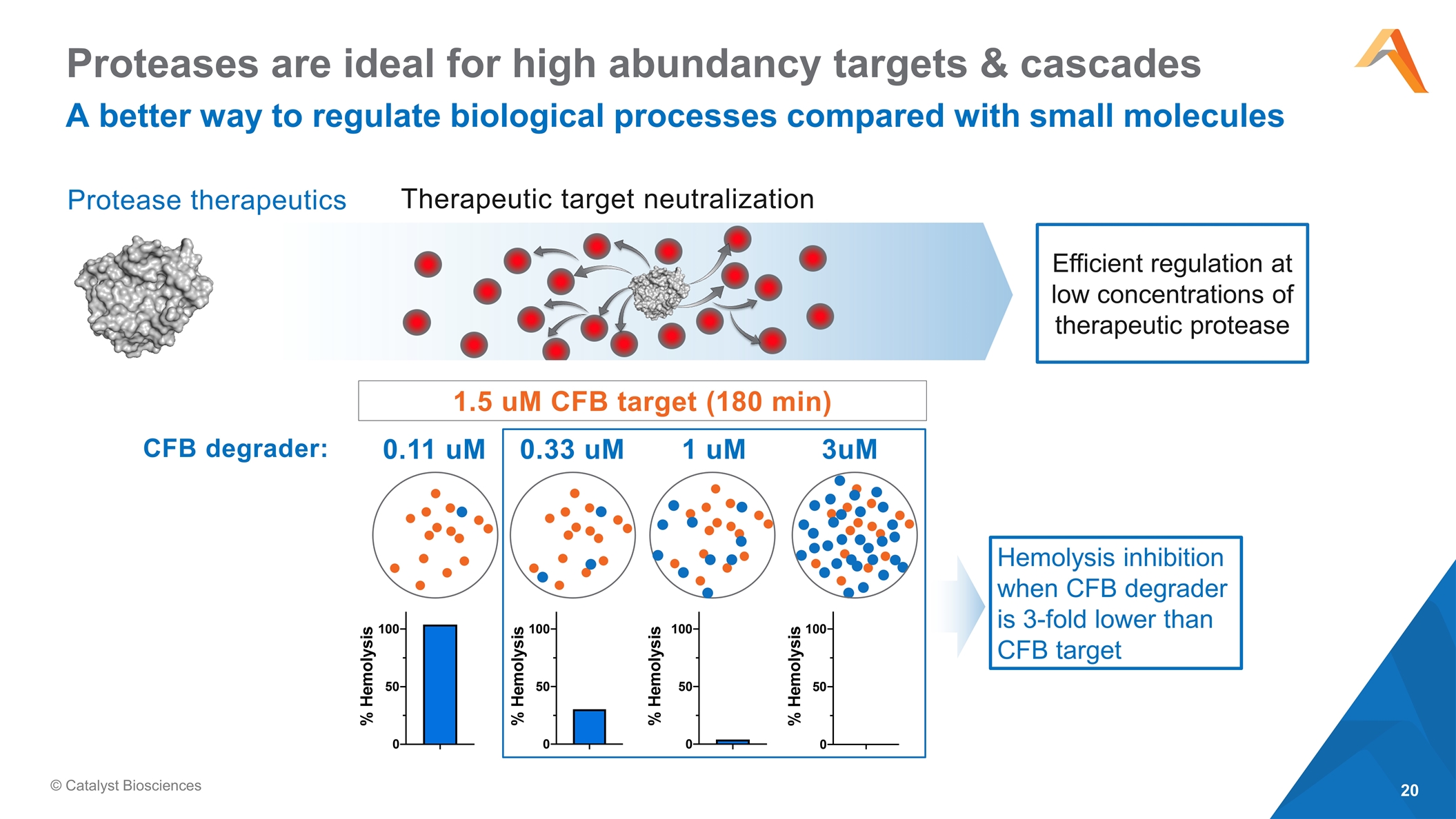
Proteases are ideal for high abundancy targets & cascades A better way to regulate biological processes compared with small molecules © Catalyst Biosciences Efficient regulation at low concentrations of therapeutic protease CFB degrader: Therapeutic target neutralization Protease therapeutics 3uM 1.5 uM CFB target (180 min) 1 uM 0.33 uM 0.11 uM Hemolysis inhibition when CFB degrader is 3-fold lower than CFB target
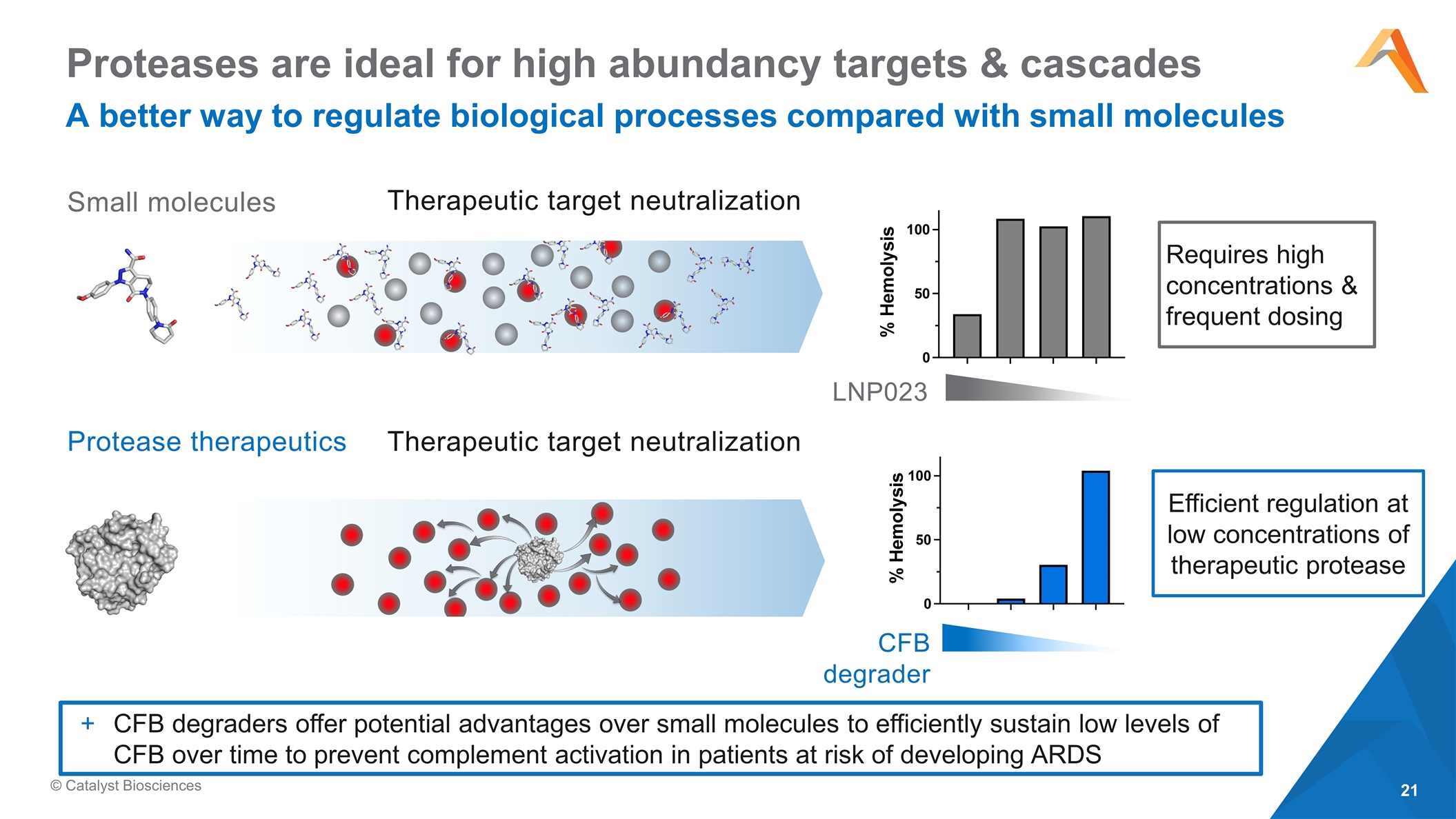
Proteases are ideal for high abundancy targets & cascades A better way to regulate biological processes compared with small molecules © Catalyst Biosciences Efficient regulation at low concentrations of therapeutic protease Requires high concentrations & frequent dosing CFB degrader LNP023 Therapeutic target neutralization Protease therapeutics Small molecules Therapeutic target neutralization CFB degraders offer potential advantages over small molecules to efficiently sustain low levels of CFB over time to prevent complement activation in patients at risk of developing ARDS
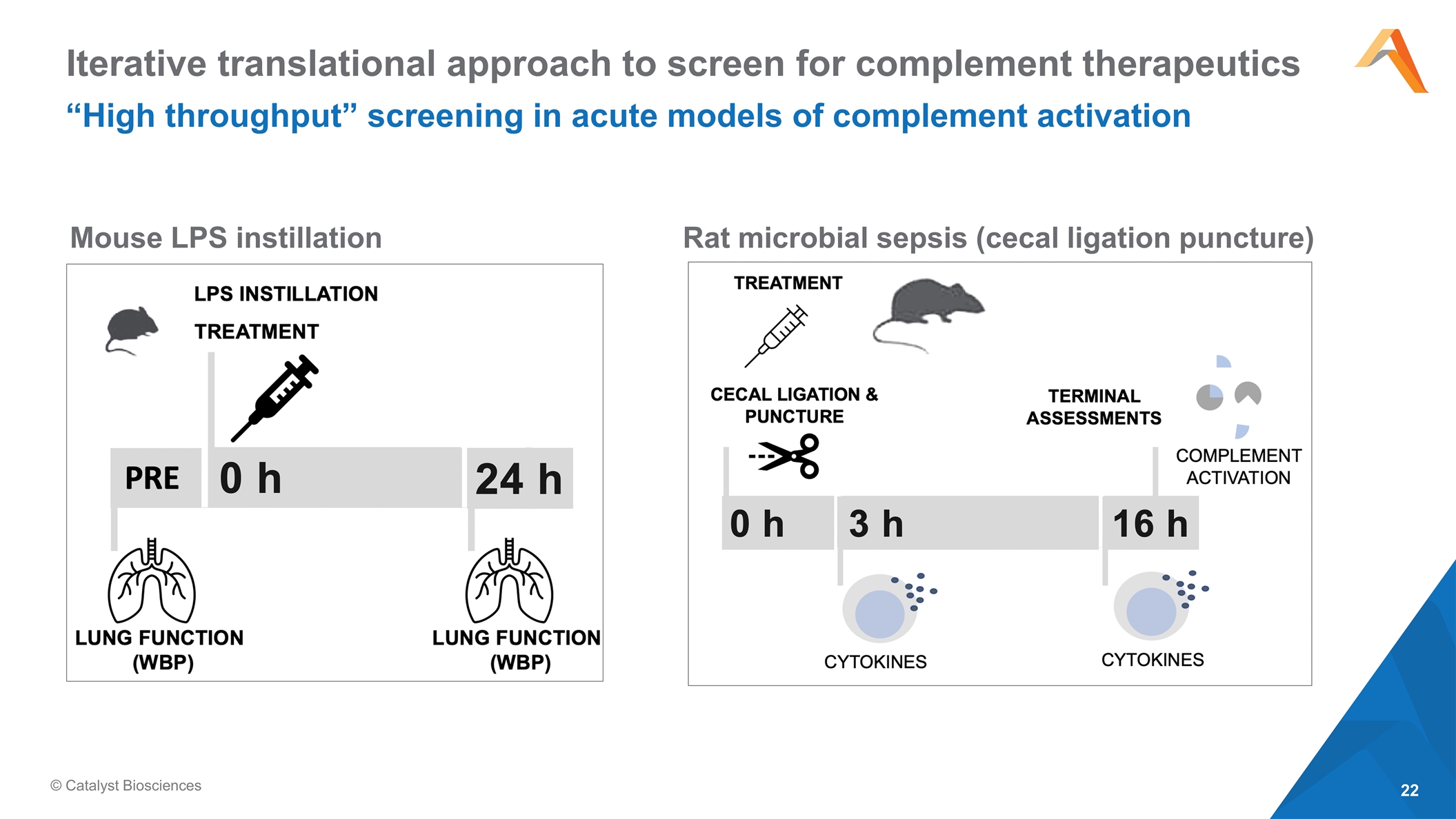
Iterative translational approach to screen for complement therapeutics “High throughput” screening in acute models of complement activation © Catalyst Biosciences Mouse LPS instillation Rat microbial sepsis (cecal ligation puncture)
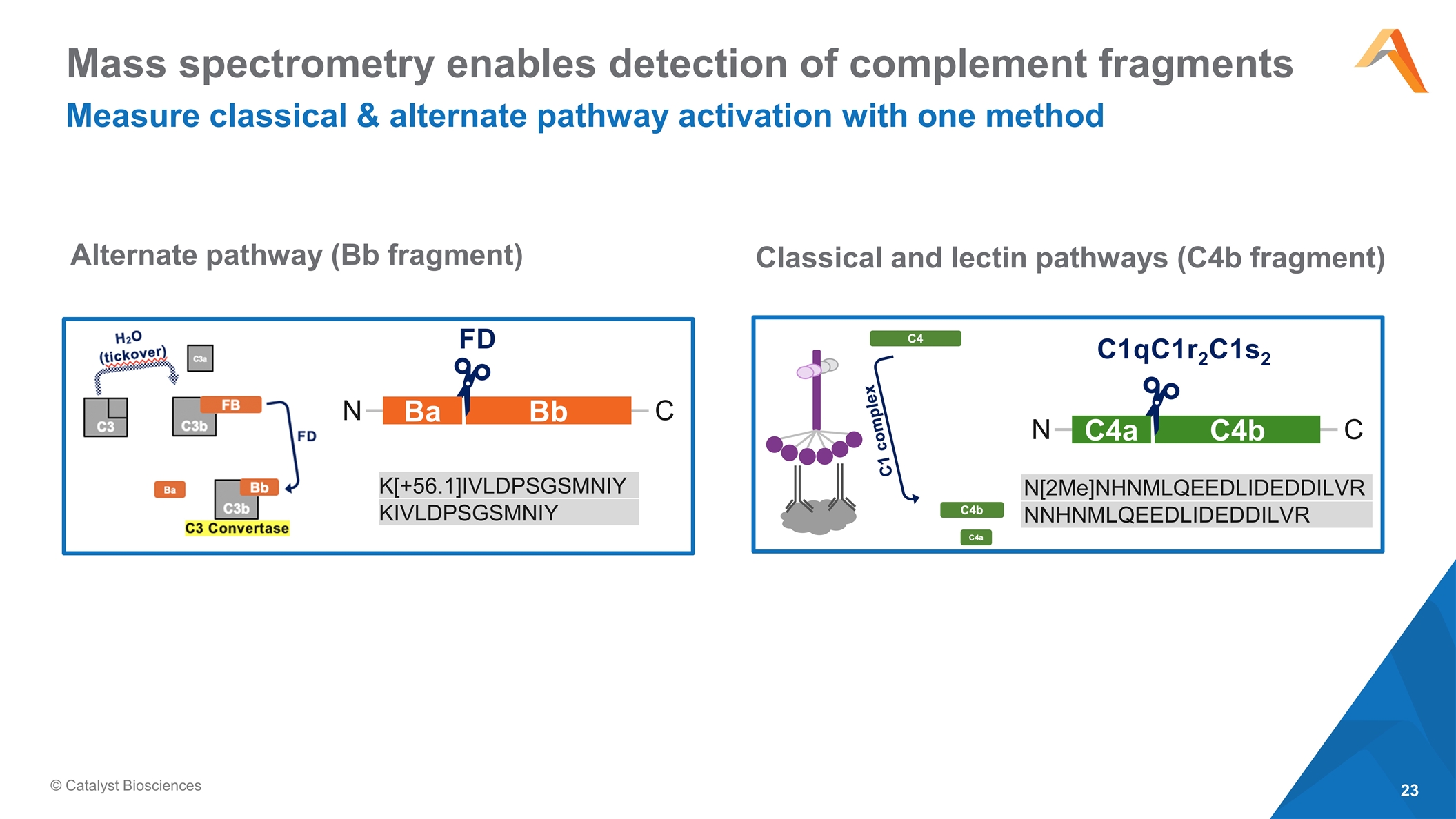
Mass spectrometry enables detection of complement fragments Measure classical & alternate pathway activation with one method © Catalyst Biosciences Bb FD Ba K[+56.1]IVLDPSGSMNIY KIVLDPSGSMNIY N C C4b C1qC1r2C1s2 C4a N C N[2Me]NHNMLQEEDLIDEDDILVR NNHNMLQEEDLIDEDDILVR Alternate pathway (Bb fragment) Classical and lectin pathways (C4b fragment)
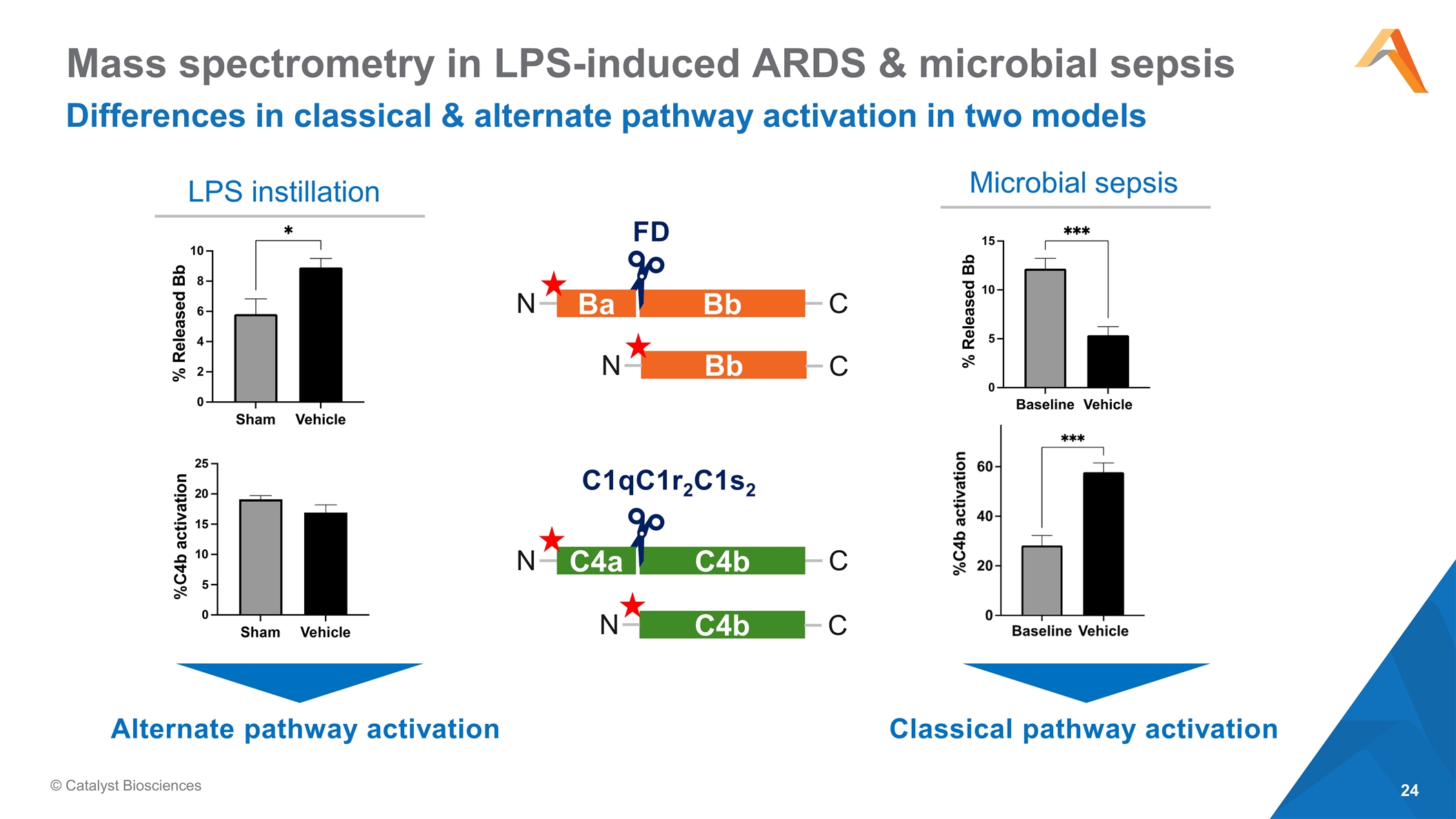
Mass spectrometry in LPS-induced ARDS & microbial sepsis Differences in classical & alternate pathway activation in two models © Catalyst Biosciences Bb FD Ba N C C4b C1qC1r2C1s2 C4a N C LPS instillation Microbial sepsis Bb C4b C N C N Alternate pathway activation Classical pathway activation
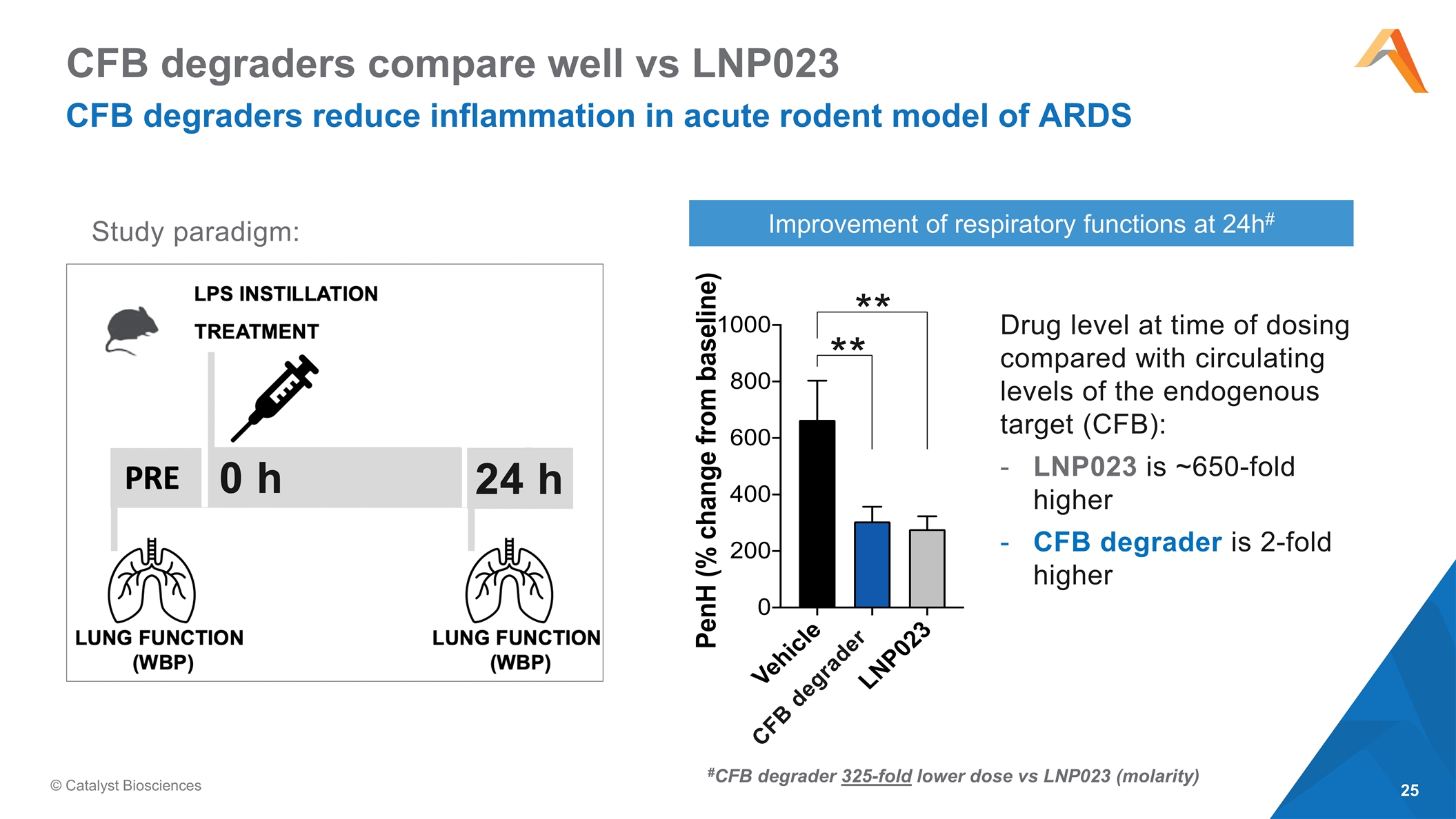
CFB degraders compare well vs LNP023 CFB degraders reduce inflammation in acute rodent model of ARDS © Catalyst Biosciences #CFB degrader 325-fold lower dose vs LNP023 (molarity) Improvement of respiratory functions at 24h# Study paradigm: CFB degrader Drug level at time of dosing compared with circulating levels of the endogenous target (CFB): LNP023 is ~650-fold higher CFB degrader is 2-fold higher
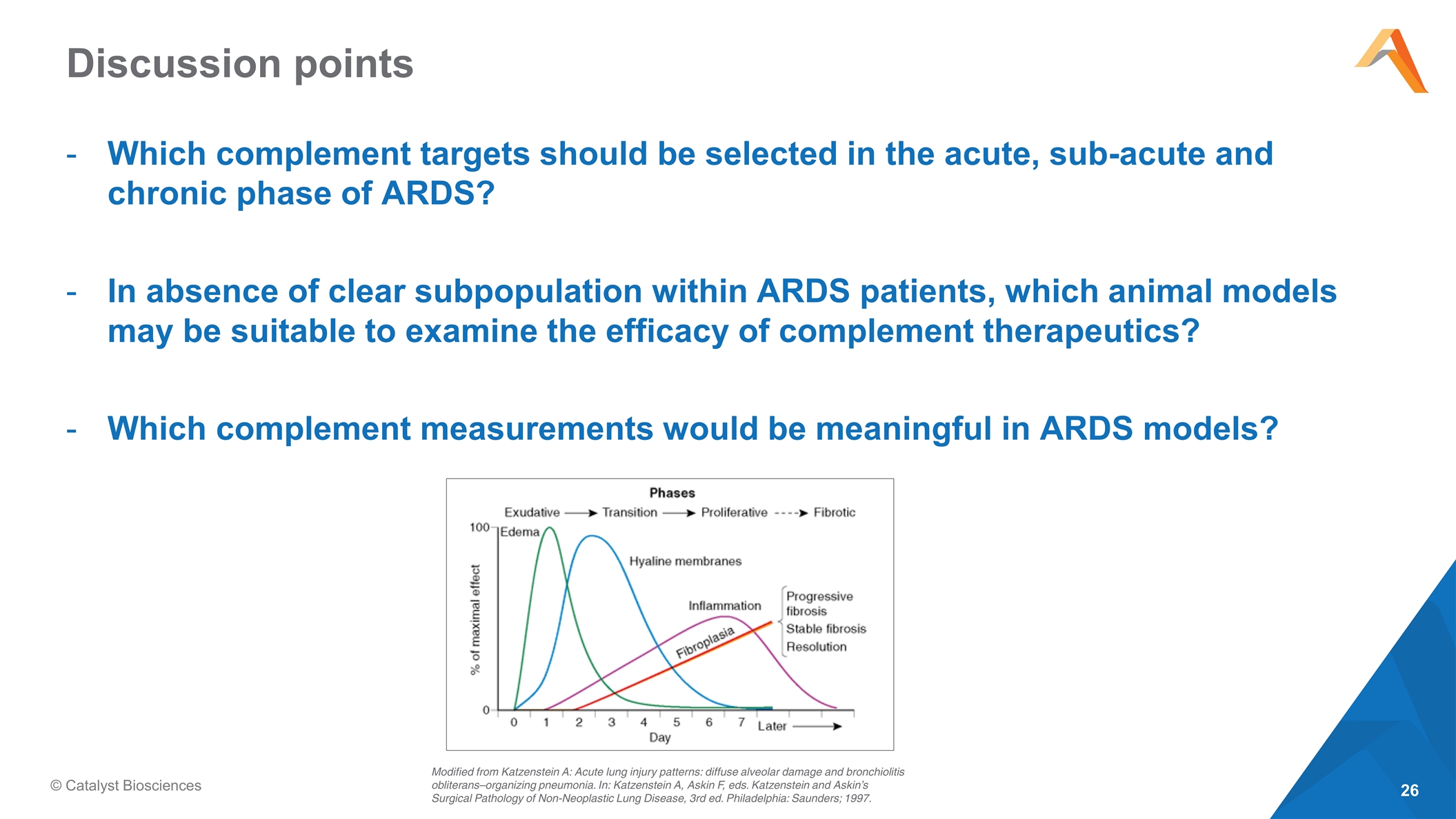
Discussion points Which complement targets should be selected in the acute, sub-acute and chronic phase of ARDS? In absence of clear subpopulation within ARDS patients, which animal models may be suitable to examine the efficacy of complement therapeutics? Which complement measurements would be meaningful in ARDS models? © Catalyst Biosciences Modified from Katzenstein A: Acute lung injury patterns: diffuse alveolar damage and bronchiolitis obliterans–organizing pneumonia. In: Katzenstein A, Askin F, eds. Katzenstein and Askin’s Surgical Pathology of Non-Neoplastic Lung Disease, 3rd ed. Philadelphia: Saunders; 1997.

























